
February 2022
Creating value,
finding focus:
Global Insurance
Report 2022
This report is a collaborative effort by Pierre-Ignace Bernard, Stephan Binder,
Alexander D’Amico, Henri de Combles de Nayves, Kweilin Ellingrud, Philipp Klais,
Bernhard Kotanko, and Kurt Strovink, representing views from McKinsey’s Insurance Practice.
Creating value, finding focus: Global Insurance Report 2022


Contents
ii
Introduction
01
Welcome to a new world
07
State of the industry
21
Strategic imperatives for insurers
27
Where to play: Focusing the portfolio

Creating value,
finding focus
Welcome to the first edition of McKinsey’s Global
Insurance Report, focused on challenges and
opportunities for carriers in the global insurance
industry. In this report, we look back at the past
year’s developments and ahead to the ways that
the industry is evolving.
The global pandemic is resurgent with yet another
wave of rising case numbers and pressure on
healthcare systems. Its effects on business are no
less significant. Over the past two years, COVID-
19 has accelerated some trends that look certain
to reshape the way insurance is underwritten,
distributed, and managed. At the same time, some
of the problems that have challenged the industry
over the past decade have not gone away, and
the complexity of the macroeconomic environment
has increased. Revenue growth is limited in
most regions; intermediaries are capturing more
value; scale economies are proving elusive;
and productivity is quite stagnant. As a result,
economic profit—that is, profit after cost of
capital—in the insurance industry is practically at
a standstill.
The industry’s problems are not lost on capital
markets. As public investors mark down
companies’ shares, private investors swoop
in to acquire closed books, and some insurers
reconsider their geographical footprints,
the fundamental structure of the industry is
coming into question. Insurers now face several
fundamental strategic questions: How can they
create more value for shareholders? Can they
unlock latent demand and improve the customer
experience? How can they regain momentum on
the long-running quest to improve productivity?
Also, what about talent? How can they reimagine
the employee proposition to attract and retain
the brightest and best after the pandemic? Finally,
how can insurers, individually and collectively,
reframe the role and purpose of insurance
in society?
To address these questions, we believe
the leadership teams of insurance carriers need to
capitalize on nine value levers:
1. Make environmental, social, and governance
(ESG) considerations a core feature of
the business model.
2. Regain relevance through product innovation
and coverage of new risks.
3. Enhance and personalize customer
engagement and experience.
4. Engage with ecosystems and insurtechs.
5. Develop new businesses for the digital age.
6. Scale impact from data and analytics.
7. Modernize core technology platforms.
8. Address the productivity imperative.
9. Reimagine culture, diversity, and ways of
working to attract and retain talent.
ii Creating value, finding focus: Global Insurance Report 2022

Addressing these nine imperatives will help
carriers answer strategic questions about “how to
play.” But the challenges and recent trends facing
the industry will force some insurers also to think
about “where to play,” to rebalance their portfolios
of businesses, and to review their capital allocation
accordingly, in particular through M&A and asset
disposals. At the end of this report, we focus on
this pressing question: Where should insurers be
active (in terms of geography, lines of business,
and position in the value chain) to renew value
creation and themselves? The recent wave of sales
of noncore businesses to buyers with different
business models suggests that a secular change
may be in the works. We might be witnessing
a period when the quest for economies of scale
and breadth of footprint, a common strategic
thrust of the past decades for many insurers,
yields to a more rigorous search for a company’s
true source of competitive advantage.
To form a strategy that addresses the challenges
of this period of intense flux, carriers will need to
put focus and local scale at center stage. Insurers
that can develop a tightly defined business
model and take advantage of the trends and
currents unleashed by the global pandemic can
restart growth, expand performance on multiple
dimensions, and renew themselves through value
creation, securing an industry-leading position in
the years to come.
Where should insurers
be active to renew value
creation and themselves?
iiiCreating value, finding focus: Global Insurance Report 2022

© Alexander W Helin/Getty Images
In coming years, the global
insurance industry will
be profoundly shaped by
some megatrends that have
emerged and accelerated
since February 2020.

The past two years may have been the most
peculiar recession and recovery in living memory.
In 2020, the human tragedy of the COVID-
19 pandemic triggered a global economic
downturn that was initially sharper than the Great
Depression. As government support programs
took shape, the recession rapidly bottomed out,
leading to a strong economic recovery in 2021.
Global financial markets took a roller-coaster ride
as well.
The impact on the insurance industry was
noticeable: in 2020, premium growth slowed
to approximately 1.2 percent (compared with
more than 4 percent per year between 2010 and
2020). Profits fell by about 15 percent from 2019.
The decline was sharpest in Asia–Pacific (down
36 percent) and was particularly driven by falling
profits in life (Exhibits 1 and 2).
Preliminary data suggest that premium growth and
profits rebounded in 2021, especially in regions
where strong vaccine rollouts have made many
activities possible again, at least periodically.
1
Welcome to
a new world
1Creating value, finding focus: Global Insurance Report 2022
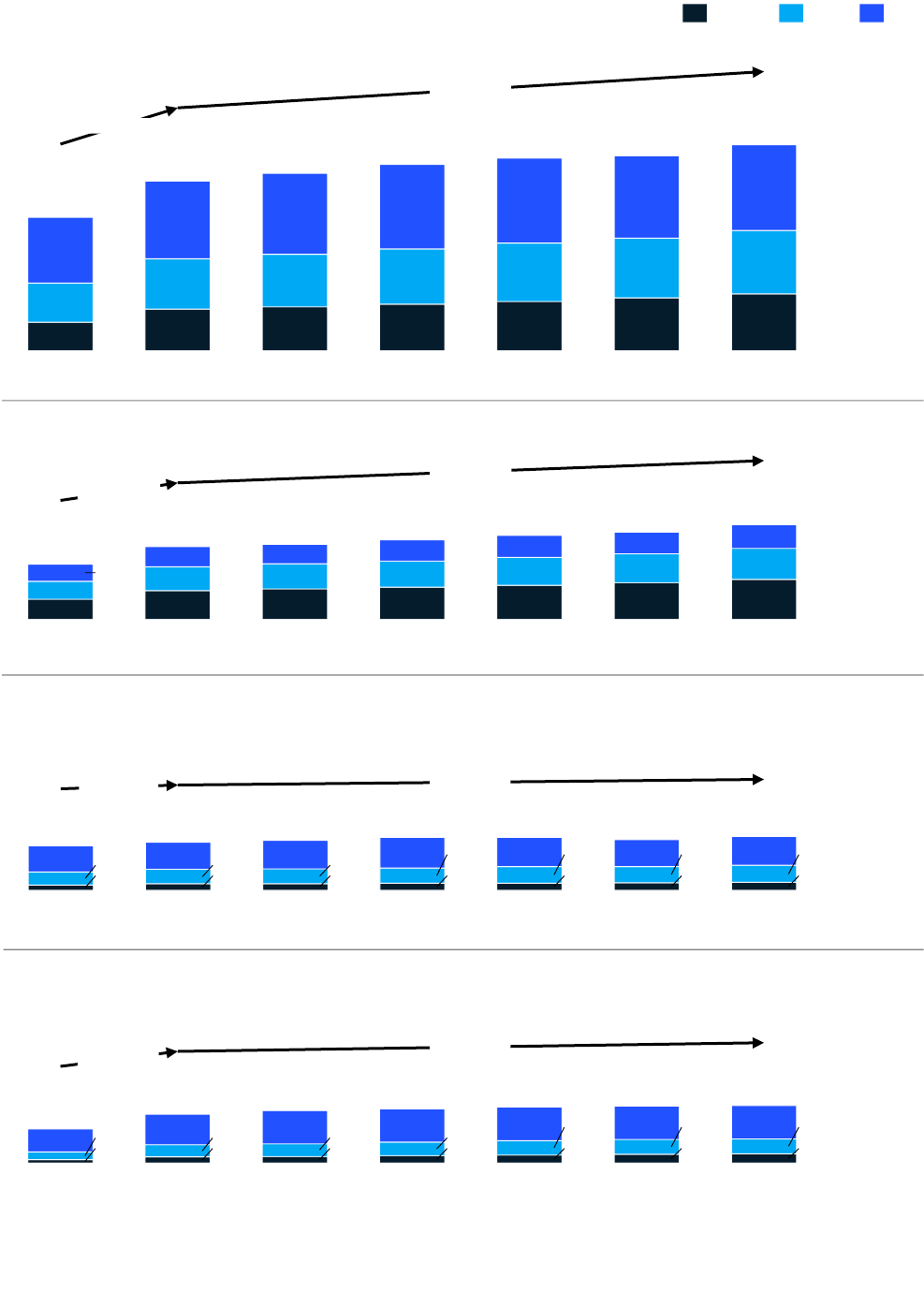
2 Creating value, finding focus: Global Insurance Report 2022
Exhibit 1
Source: McKinsey Global Insurance Pools
Premium growth rebounded in 2021 after slowing in 2020.
Note: Figures may not sum, because of rounding.
Based on 2020 average xed exchange rate.
Per annum.
Global insurance gross premiums written, $ billions
1
5,602
5,421
3,878
5,672
2,348
1,531
1,834
5,157
1,440
2,491
2,389
1,662
1,363
1,735
1,604
1,278
1,214
1,459
2,258
4,932
1,909
1,700
843
2,454
1,548
5,987
1,126
2,462
4.1% p.a.
2
4.0% p.a.
2
Americas
Asia–Pacic
Europe, Middle East, and Africa
1,606
2,116
726
2,185
691
1,164
905
2,442
580
693
1,078
635
2,761
944
759
828
999
607
2,541
845
569
586
2,310
890
489
810
633
531
4.7% p.a.
2
5.5% p.a.
2
5
6
2
CAGR, %
2016–21
Health P&C Life
479472
204
376
196
831
420
786
159
435
229217
780
1,533
212
823
882
1,288
1,453
1,395
189
1,536
1,475
753
450
848
498
1,558
1.3% p.a.
2
2.2% p.a.
2
967
2010
252
668
2019
1,627
1,656
431418
269
1,668
892
980
1,574
2020E
395
2018
1,519
214
371
2021E
192
975
229
956
984
2017
429
180
1,421
965
349
2016
2010 2019 2020E2018 2021E20172016
2010 2019 2020E2018 2021E20172016
2010 2019 2020E2018 2021E20172016
98
219
6.3% p.a.
2
3.3% p.a.
2
6
7
4
3
4
1
4
8
2
Premium growth rebounded in 2021 after slowing in 2020.
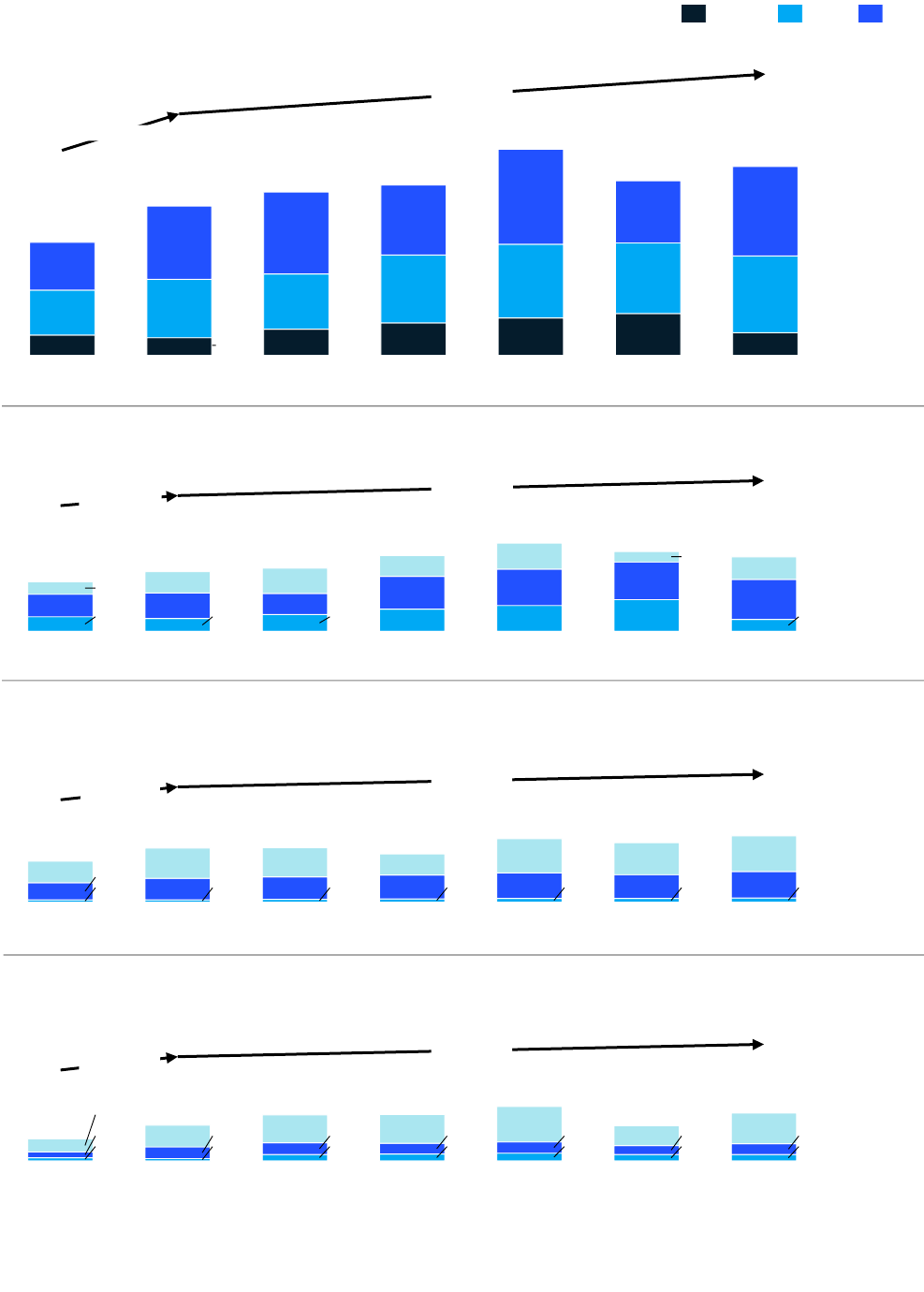
3Creating value, finding focus: Global Insurance Report 2022
Exhibit 2
Industry prots increased in 2021 after a dip in 2020.
Source: McKinsey Global Insurance Pools
Note: Figures may not sum, because of rounding.
Based on 2020 average xed exchange rate.
Per annum.
34
Global insurance after-tax prots, $ billions
1
170
332
79
311
90
181
134
118
71
62
360
134
215
392
147
50
105
156
111
284
86
140
43
128
139
39
324
4.8% p.a.
2
4.8% p.a.
2
88
53
88
104
67
12
41
59
12
11
13
22
37
15
21
5
68
7
67
18
13
91
22
43
2121
2021E2016 2020E2018 201920172010
2021E2016 2020E2018 201920172010
2021E2016 2020E2018 201920172010
2021E2016 2020E2018 201920172010
25
55
8.1% p.a.
2
6.1% p.a.
2
103
51
56
40
68
126
7
49
7
121
42
46
78
57
65
45
104
40
32
4
92
6 875
114
61
41
4.7% p.a.
2
4.3% p.a.
2
49
28
49
60
43
23
20
152
70
142
62
43
71
94
144
42
39
49
32
41
47
120
24
75
41
167
24
113
3.1% p.a.
2
4.6% p.a.
2
Health P&C Life
Americas
Asia–Pacic
Europe, Middle East, and Africa
6
5
4
CAGR, %
2016–21
9
–1
1
5
10
4
–1
19
7
Industry profits increased in 2021 after a dip in 2020.

Megatrends in the
post-COVID-19 world
In coming years, the global insurance industry will
be profoundly shaped by some megatrends that
have emerged and accelerated since February
2020. Some are shifts in the macroeconomy;
others are changes in competitive dynamics.
The most dramatic may be changes in customer
and employer behaviors. While most of these
trends are not completely new, they have
accelerated during the pandemic. In aggregate,
they are shaping a new operating environment
for insurers that is hugely disruptive and that
challenges traditional ways of value creation.
These trends, in brief, include the following:
— A decoupling of macroeconomic
environments among Asia, Europe, and
North America, whether through elevated
geopolitical and trade tensions or different
interest rate trends between regions. (For
example, while the situation remains highly
ambiguous, the United States may be exiting
the “low for long” rate environment on the back
of a noticeable though perhaps transitory
spike in inflation). In areas where low rates
continue to prevail, this could put even more
pressure on life insurers to revamp their
business models accordingly.
— A dichotomy between ‘winners’ and ‘losers,’
reinforced by the crisis. The economic
impact of the COVID19 pandemic has varied
considerably by geography (for example, Asia,
Europe, and North America are recovering at
different speeds); by sector (for example, travel
and hospitality suffered a deep recession,
whereas e-commerce companies soared);
and within each sector (resulting in intense
M&A activity). The past two years have thus
reinforced the superstar phenomenon
1
—the
growing concentration of economic success—
that we have observed not just among
companies but also in cities, economic sectors
such as insurance, and other aspects of
the global economy. Among the world’s largest
companies, economic profit is distributed
unequally along a “power curve,” with the top
10 percent of firms capturing 80 percent of
1
For more, see “What every CEO needs to know about ‘superstar’ companies,” McKinsey Global Institute, April 2, 2019.
2
Arun Arora, Hamza Khan, Sajal Kohli, and Caroline Tufft, “DTC e-commerce: How consumer brands can get it right,” McKinsey,
November 30, 2020.
it. The insurance industry has not escaped
this trend, moving from a moderately value-
creating industry to one that destroys value—
and the trend is even stronger at the company
level. Half of insurers globally are not earning
their cost of capital, and half are trading below
book value.
— A potential anchoring of remote-interaction
models with customers. The pandemic
saw a “decade in days” acceleration in digital
uptake—for example, e-commerce sales in
the United States grew as much in the first
half of 2020 as in the previous ten years.
2
Tech
players’ platforms strengthened their position
as go-to places for customers. The frequency
of interactions and the level of personalization
have dramatically changed, and insurers
need to ensure they stay relevant and can
craft truly personal, needs-based contextual
experiences. This situation will probably
provide tailwinds for insurtechs and other
digital attackers, raising the risk of disruption
for incumbents. To fend off the threat, insurers
will need to make additional IT investments
to digitalize and automate their processes; if
the trend persists, they might even need to
significantly modify their distribution models
by repositioning the roles of agencies, brokers,
and digital sales channels.
— An increased awareness of sustainability,
climate change, and issues of diversity,
equity, and inclusion (DE&I). Corporates
and customers alike have become attuned to
a broader range of environmental and energy
issues, as well as situations of social, racial,
and generational injustice. This will have
an immediate impact on insurers, particularly
in their investment and underwriting portfolios,
as governments set target dates to reach
net-zero emissions. In addition, natural
catastrophes abounded in 2020 and 2021,
leaving insurers wondering whether these
patterns represent extraordinary activity
or the new normal—in which case, they will
need to examine whether their pricing models
adequately account for these events.
4 Creating value, finding focus: Global Insurance Report 2022

— New challenges to the purpose and
relevance of insurers. Just as the financial
crisis of 200709 put the spotlight on
the banking industry, the pandemic and
its associated insurance issues have put
the spotlight on the insurance industry. This
might prompt insurers to rethink their societal
purpose and relevance in the economy as
a risk-taking industry. There is a perception
that the industry has lost this characteristic in
the past ten years by limiting the types of risks
or clients it covers (as seen in Europe, where
life insurance has moved sharply toward unit-
linked products).
— A rethinking of mobility. Commercial aviation
and other forms of travel fell sharply over
the past two years; shared mobility
3
and
micromobility
4
fell, then resumed their steady
rise. Next steps might include a rebalancing
among modes of transport; for example,
COVID19 habits might result in a continued
preference for individual car use over public
transport but also in less driving overall as
people continue to work from home. This
might encourage insurers to reexamine
their product offerings on severely affected
lines of business (such as life, travel, and
events) and to innovate. For example, they
might cover emerging mobility needs, make
new use of telematics, or engage in mobility
ecosystems
5
—being thoughtful and realistic
3
Lennart Andersson, Andreas Gläfke, Timo Möller, and Tobias Schneiderbauer, “Why shared mobility is poised to make a comeback after
the crisis,” McKinsey, July 15, 2020.
4
Kersten Heineke, Benedikt Kloss, and Darius Scurtu, “The future of micromobility: Ridership and revenue after a crisis,” McKinsey, July
16, 2020.
5
Insurance insights that matter, “A view from the Pacific Insurance Conference: How to create a successful insurance ecosystem,” blog
entry by Bernhard Kotanko, McKinsey, January 8, 2020.
6
“Digital health ecosystems: A payer perspective,” McKinsey, August 2, 2019.
7
For more, see “The consumer demand recovery and lasting effects of COVID19,” McKinsey Global Institute, March 17, 2021.
8
“Digital ecosystems for insurers: Opportunities through the Internet of Things,” McKinsey, February 4, 2019.
9
Aaron De Smet, Bonnie Dowling, Mihir Mysore, and Angelika Reich, “It’s time for leaders to get real about hybrid,” McKinsey Quarterly,
July 9, 2021.
10
Insurance insights that matter, “Why insurers should embrace remote work,” blog post by Julie Goran and Tom Welchman, McKinsey,
April 21, 2021.
about their role in a world increasingly
dominated by platform companies.
— A renewed focus on health and well-being
and a greater interest in home nesting.
The ongoing health crisis could leave a mark
on consumers’ psyches for a generation and
could inspire insurers to actively participate
in health and protection ecosystems.
6
At
the same time, consumers are now hooked on
“home nesting,” or leisure activities at home
(such as cooking, DIY projects, meditation,
and streaming entertainment). According to
the McKinsey Global Institute, home nesting
is one of the new behaviors most likely to
endureafter the pandemic.
7
In response,
insurers might invest in smart-home
8
services
and offerings such as discounts on homes
equipped with devices that can detect fire,
flood, or unwanted visitors.
— The dawn of new ways of working. Almost all
companies are trying to figure out new hybrid
working models
9
; so are many professions that
have close contact with customers. This will
have a huge impact on the insurance industry.
Carriers will have to identify the skills required
to manage remote and hybrid teams
10
and
review their real estate needs—both to adjust
to a changing workforce and to match clients’
new geographical footprints (for example,
as people move to midsize cities, suburbs,
and exurbs).
Several megatrends are shaping
a new operating environment for
insurers that is hugely disruptive
and that challenges traditional
ways of value creation.
5Creating value, finding focus: Global Insurance Report 2022

© Suzana Topita/Getty Images
Insurance barely earns
its cost of capital, making
investors skeptical.

2
State of the
industry
Old challenges still loom
Even before 2020, the insurance industry faced
challenges. Now, those issues have taken on even
greater urgency:
— Headwinds on revenue growth. Three
structural factors are challenging industry
growth (Exhibits 3 and 4): persistent low
interest rates, which pressure spread-based
businesses such as life insurance; pricing
pressures driven by fee transparency, digital
attackers, and lower-cost options—pressures
that in some markets are aggravated by price
comparison websites; and organic demand
that is growing only slowly in mature markets.
The latter is particularly worrying, because
growth in developed economies is coming
mostly from price increases rather than from
volume or new risks covered, highlighting
a risk that the industry might lose its relevance
over time.
7Creating value, finding focus: Global Insurance Report 2022
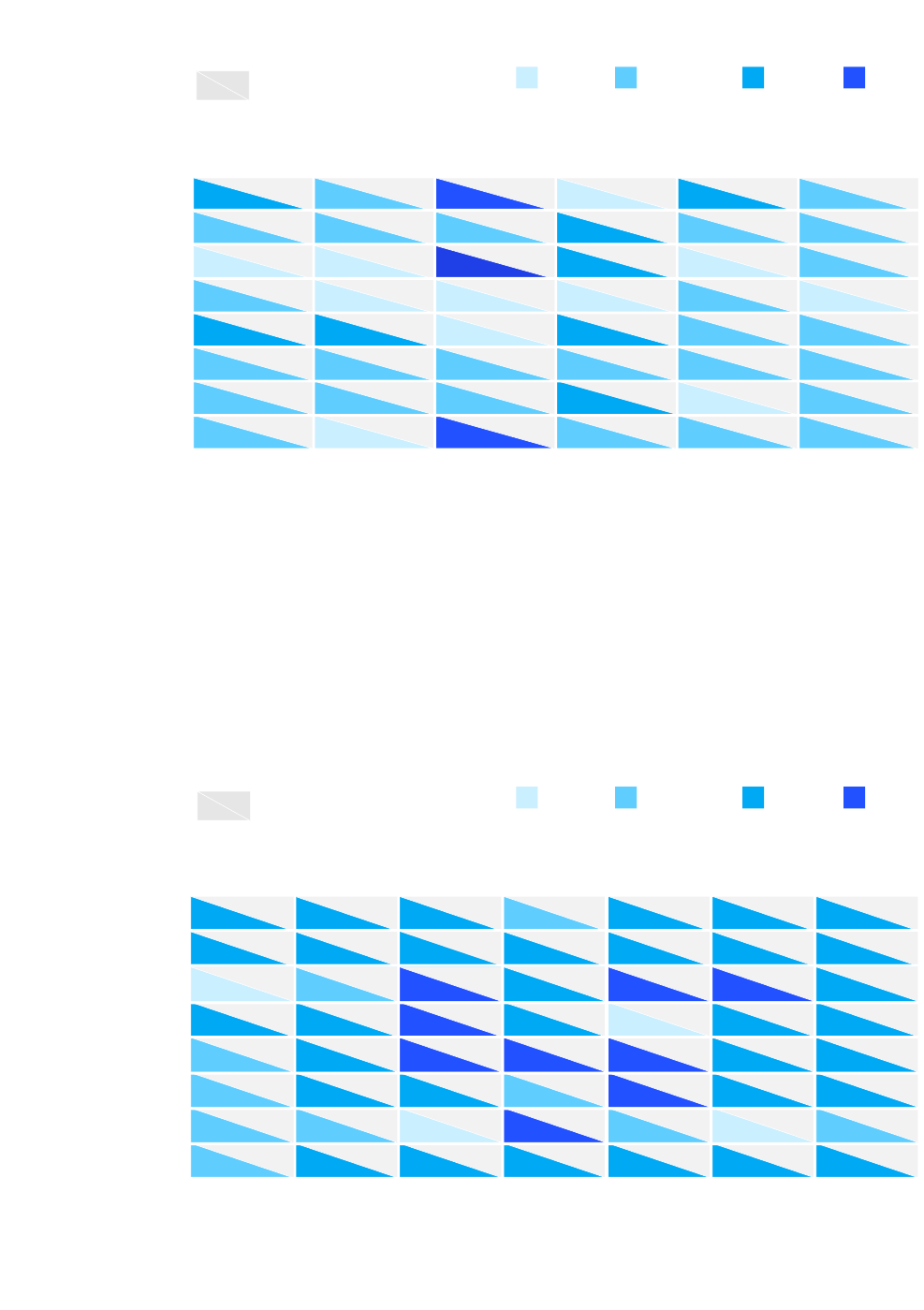
8 Creating value, finding focus: Global Insurance Report 2022
Exhibit 3
Source: McKinsey Global Institute; McKinsey Global Insurance Pools
In life, revenue growth in much of the world is subdued.
Note: Figures may not sum, because of rounding.
Based on average xed exchange rate.
Growth in nominal premiums and GDP, 2016–21.
Percentage points.
Global revenues by life insurance product and region, 2021E
Gross direct domestic premiums written (GDDPW), $ billions
1
Growth rates
<–3 ppt³
–3 to 0 ppt³ >3 ppt³0–3 ppt³
Dierence between premiums
and GDP growth,
2
ppt
3
2021 GDDPW
Individual
term life
Individual
endowments
Individual
annuities
Unit-linked Group life Total
North America
0.5
40
–2.9
118
3.7
140
–5.7
109
0.9
224
–0.7
630
Western Europe
–0.3
26
–2.3
238
–2.9
72
2.7
175
–2.1
240
–1.2
749
Emerging Asia
–6.9
9
–9.9
212
16.2
210
0.8
34
–5.9
20
–1.4
484
Developed Asia
–1.2
95
–3.5
231
–9.6
45
–3.5
47
–2.7
66
–3.7
483
Latin America
0.3
7
1.9
2
–13.0
4
0.9
39
–1.5
11
–0.8
62
Africa and Middle East
–1.6
3
–1.6
18
–0.6
3
–0.8
15
–1.3
21
–1.2
59
Eastern Europe
–1.8
2
–2.9
5
–2.8
1
0.5
11
–4.6
4
–1.5
22
Total
–3.0
181
–5.6
824
3.5
473
–2.1
428
–2.9
584
–2.7
2491
In life, revenue growth in much of the world is subdued.
Exhibit 4
In nonlife, North America has been the highest-growth region compared to
GDP in recent years.
Source: McKinsey Global Institute; McKinsey Global Insurance Pools
Note: Figures may not sum, because of rounding.
Based on average xed exchange rate.
Growth in nominal premiums and GDP, 2016–21.
Percentage points.
Global revenues by nonlife insurance product and region, 2021E
Gross direct domestic premiums written (GDDPW), $ billions
1
Dierence between premiums
and GDP growth,
2
ppt
3
2021 GDDPW
Motor
Fire and
property Liability Accident
Other
P&C Health Total
North America
0.9
339
2.6
245
1.0
214
–0.9
14
1.9
43
2.6
1,147
2.1
2,002
Western Europe
0.3
151
1.3
109
1.7
35
0.8
50
1.6
58
1.6
204
1.2
608
Emerging Asia
–5.1
132
–0.4
15
13.7
16
1.7
20
4.9
44
7.6
134
1.2
361
Developed Asia
0.2
85
2.9
35
3.2
17
2.8
43
–3.2
25
1.8
135
1.3
339
Latin America
–2.7
21
2.5
12
3.7
3
3.1
7
4.6
8
1.5
17
0.8
67
Africa and Middle East
–1.1
27
1.0
9
2.0
3
–0.1
3
4.2
9
2.0
21
0.8
72
Eastern Europe
–2.3
22
–2.5
9
–4.2
3
9.8
5
–1.7
3
–3.8
4
–1.5
47
Total
–1.1
777
0.9
434
0.7
291
0.2
142
0.9
190
1.8
1,662
0.8
3,497
Growth rates
<–3 ppt³
–3 to 0 ppt³ >3 ppt³0–3 ppt³
In nonlife, North America has been the highest-growth region compared to GDP in
recent years.
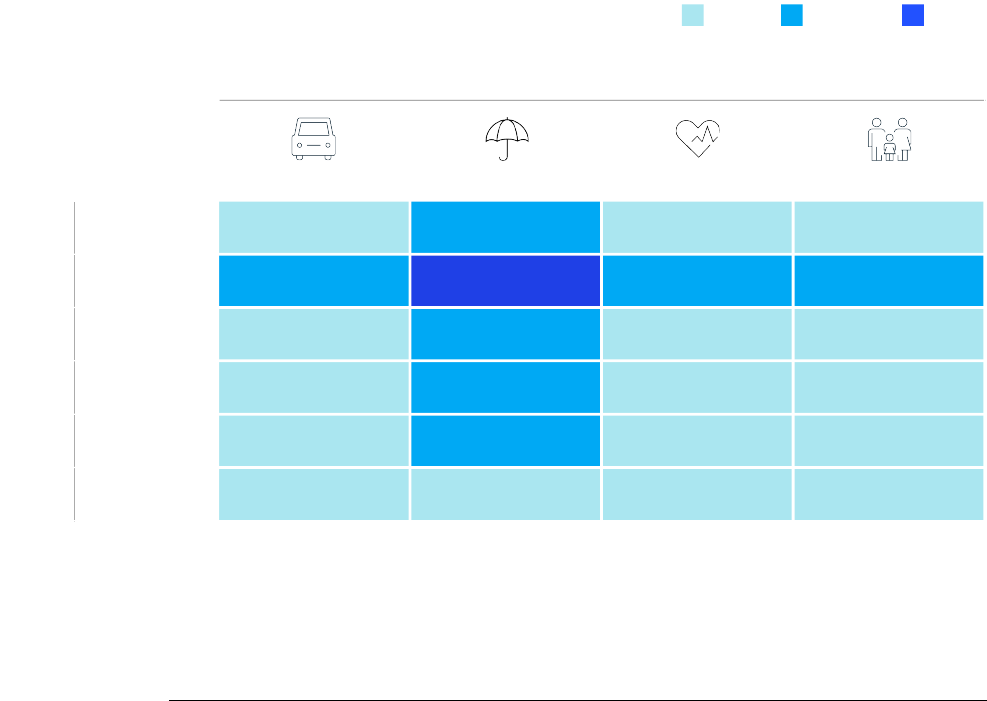
— An ongoing ‘fight for the customer.’
Insurtechs are driving digital innovation and
disruption in the industry,
11
with investments
in insurtechs worldwide growing from
$1 billion in 2004 to $7.2 billion in 2019 to
$14.6 billion in 2021. More than 40 percent
of insurtechs are focused on the marketing
and distribution segments of the insurance
value chain (Exhibit 5), enabling them to
solve customer pain points through a digitally
enhanced client experience that could pose
a competitive threat to incumbents. And while
some of these players have seen their share
price tumble since their IPOs, we believe that
a distinctive digital customer experience—from
attackers or incumbents—will be a prerequisite
for industry-beating growth. And beyond
distribution, superior technology and healthy
margins in insurance service businesses will
challenge the traditional approach of many
insurers to own the whole value chain—they
will be forced to form partnerships or make
outsize investments to keep up.
11
Tanguy Catlin, Simon Kaesler, Alex Kimura, and Pradip Patiath, “Global perspectives on insurtechs,” McKinsey, September 30, 2021.
12
Ramnath Balasubramanian, Grier Tumas Dienstag, Katka Smolarova, and Ruxandra Tentis, “The insurance trends private-equity
investors should understand in 2021,” McKinsey, August 20, 2021.
— A value shift toward intermediaries. Over
the past five to ten years, brokers have
emerged as the clear winners of the industry,
with both public and private investors
recognizing their position of strength in
the insurance value chain (Exhibit 6). Total
shareholder returns are much higher for
brokers than for other industry segments, and
private-equity firms are investing.
12
In 2019,
for example, CVC Capital Partners invested in
April, and GTCR invested in AssuredPartners.
PE-backed brokerage deals completed in
the United States accounted for roughly
three-quarters of all insurance transactions
from 2016 to 2019. Because insurers do not
control their distribution channels as tightly as
other financial sectors (though it depends on
the region and line of business, as illustrated in
Exhibit 7), they might run an even greater risk
of becoming pure balance-sheet providers,
while intermediaries keep an asset-light client
relationship model. The shift toward digital is
perhaps the last chance for insurers to regain
the upper hand in this “fight for the customer.”
9Creating value, finding focus: Global Insurance Report 2022
Exhibit 5
Source: McKinsey Global Insurance Pools; McKinsey insurtech database
Insurtechs are concentrated in marketing and distribution.
Note: Overlaps exist because some insurtechs provide solutions for multiple P&C subproducts and operate across multiple value chain components.
Insurtech database includes ~2,000 proles as of 2020.
Including accident, re and property, liability, and other P&C insurance.
Includes IT, HR, nance, and other support functions.
Products
P&C: Motor P&C: Other
2
Health Life
Value
chain
Product
development
2 5 2 2
Marketing and
distribution
8 21 7 7
Pricing and
underwriting
3 6 2 2
Policy
management
2 5 2 2
Claims
3 6 2 1
Other
3
1 4 2 2
Insurtechs by product and business activity, % of database total
1
<5% 5–10% >10%
Insurtechs are concentrated in marketing and distribution.

10 Creating value, finding focus: Global Insurance Report 2022
Exhibit 6
Source: Bloomberg; Capital IQ; Renitiv Eikon
Brokers and North American insurers produced the best returns in the past
decade.
Note: The following sectoral indexes have been considered: Renitiv Global Reinsurance Index, S&P Global 1200 Insurance Brokers TR Index, S&P Global 1200
Life & Health Insurance TR Index, S&P Global 1200 Multiline Insurance TR Index, S&P Global 1200 Property & Casualty Insurance TR Index, STOXX Asia/Pacic
600 Insurance Index, STOXX Europe 600 Insurance Index, STOXX North America 600 Insurance Net Return Index.
Annualized TSR by line of business, %
21.9
14.9
12.7
9.8
9.7
Life and health
P&C
Reinsurers
Global brokers
Multiline
53.4
19.8
14.9
7.0
–4.4
15.6
8.7
4.9
Asia–Pacic
North America
Europe, Middle
East, and Africa
25.1
–3.4
–0.2
2010–19
2020–21
Annualized TSR by geography, %
Brokers and North American insurers produced the best returns in the past decade.
Exhibit 7
Source: McKinsey Global Insurance Pools
Distribution channels dier by geography and line of business.
Note: Figures may not sum to 100%, because of rounding.
Gross premiums written by
distribution channel, 2015–20, %
Dominant
distribution
channel
Bancassurance
Brokers Direct and other
Tied agents and branches
49 52
29
27
9
20202015
12
11
11
Asia–Pacic
Americas
Life regional total
Europe, Middle East, and Africa
61
59
15
16
22
23
3
20202015
3
36
27
48
53
9
11
6
2020
9
2015
24
27
58
53
11
8
10
9
20202015
26
22
43
46
29
31
2020
1
3
2015
P&C regional total
0
0
58
59
33
29
20202015
9
11
DDeellttaa
2015–20
DDeellttaa
2015–20
–2
3
–2
1
–4
1
0
2
1
1
–2
0
5
2
–9
3
–5
3
1
1
2
3
–2
–4
DDeellttaa
2015–20
Life regional total
P&C regional total
Life regional total
P&C regional total
Distribution channels differ by geography and line of business.
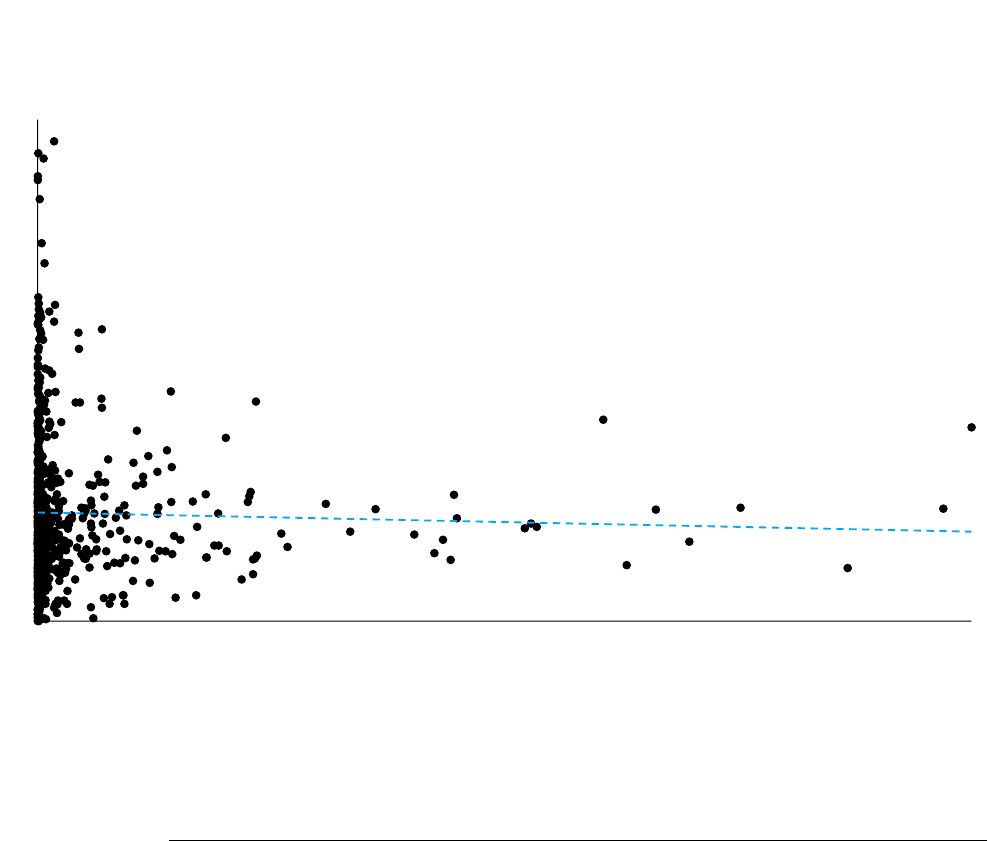
— Elusive economies of scale. Many segments
of the insurance industry have been seeking
scale in recent years. In North America, for
example, increased scale was a primary
goal for 60 percent of recent acquisitions.
13
The results have been meager: globally, scale
does not seem to be producing higher ROE
(Exhibit 8). It turns out that trying to achieve
scale on a global level has been a recipe for
becoming average.
Importantly, this does not hold true for local or
national scale effects; on these levels, scale is
correlated with profitability (Exhibit 9).
The fragmentation of the industry in several
countries (Exhibit 10), coupled with this
scale effect at the local level, could present
13
“A better approach to M&A in North American insurance,” McKinsey, March 9, 2021.
14
“The productivity imperative in insurance,” McKinsey, August 14, 2019.
an opportunity for a value-creating wave of
local consolidation in the industry.
— Limited productivity improvement. Though
many insurers have undertaken cost savings
programs, the aggregate results have not
been fruitful. Industry-wide, productivity
improvements have been limited.
14
Exhibit 11
offers an illustration: between 2014 and 2019,
expense ratios fell for only 45 percent
of global P&C carriers (with important
variations across regions). For many, ratios
did not budge or actually rose. That’s
a disappointing outcome for an industry that
has communicated so much on the need for
productivity improvements.
11Creating value, finding focus: Global Insurance Report 2022
Exhibit 8
Source: Capital IQ; Company annual reports; SNL Financial
There is little evidence of global scale eects.
Return on equity and assets for listed and nonlisted insurers, 2016–20, n = 630 insurers worldwide
30
40
25
20
45
15
10
5
0
50
600,000
35
400,000200,000 800,000 1,000,0000
Average ROE
2016–20, %
Average assets (2016–20)
$ millions
R
2
= 0.0007
There is little evidence of global scale effects.
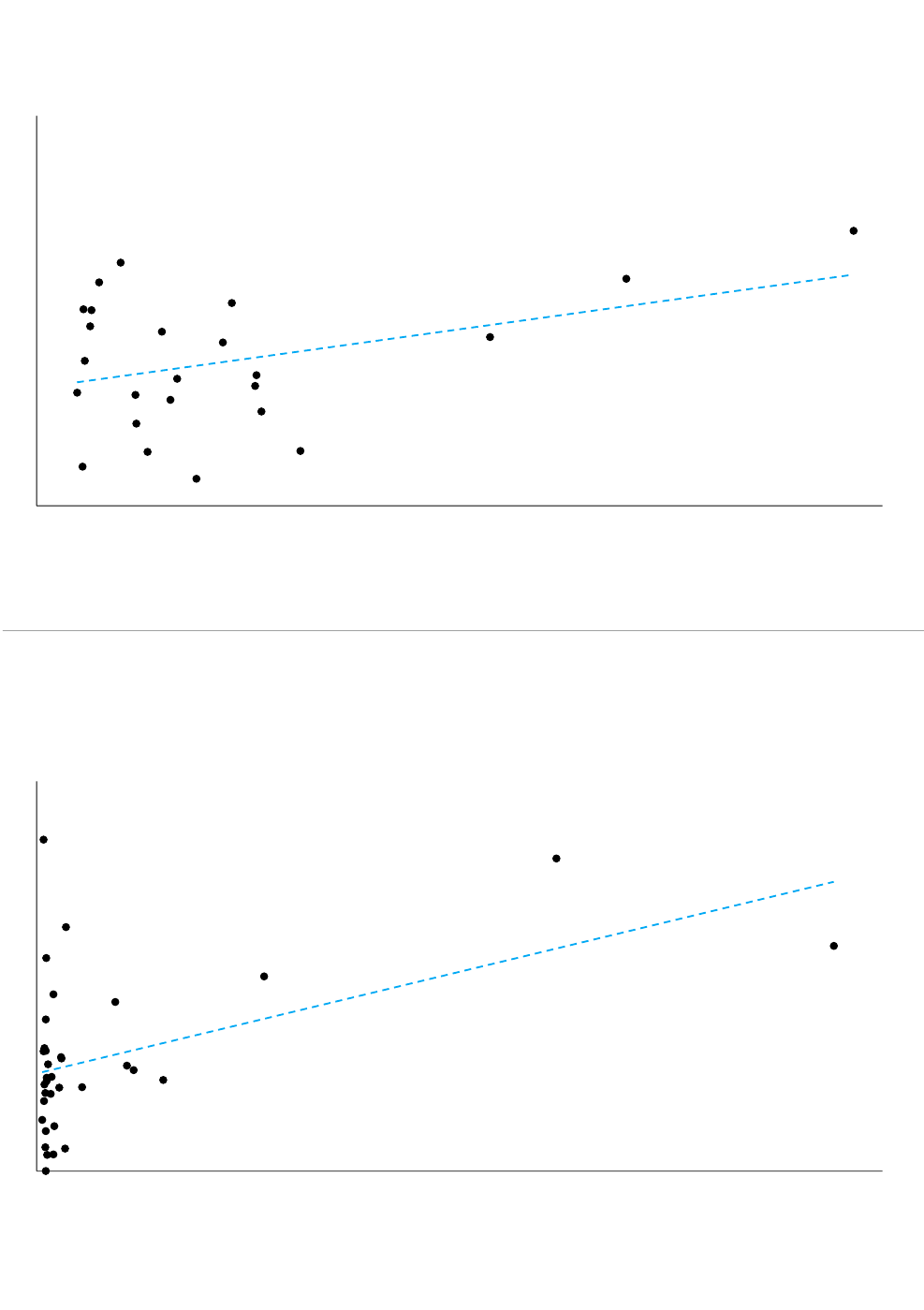
12 Creating value, finding focus: Global Insurance Report 2022
Exhibit 9
Source: McKinsey Global Insurance Pools
Scale eects can occur within local and national markets.
Return on equity and assets for life insurers in Italy, 2016–20, n = 24 insurers
25
15
0
40,000
5
20
120,0000
10
80,00060,000 100,00020,000
Average assets (2016–20)
$ millions
Average ROE
2016–20, %
R
2
= 0.150
R
2
= 0.231
15
25
5
0 60,000 70,00010,000 50,000 80,000
0
40,000
20
30,000 90,00020,000
10
Average ROE
2016–20, %
Average assets (2016–20)
$ millions
Return on equity and assets for P&C insurers in China, 2016–20, n = 35 insurers
Scale effects can occur within local and national markets.
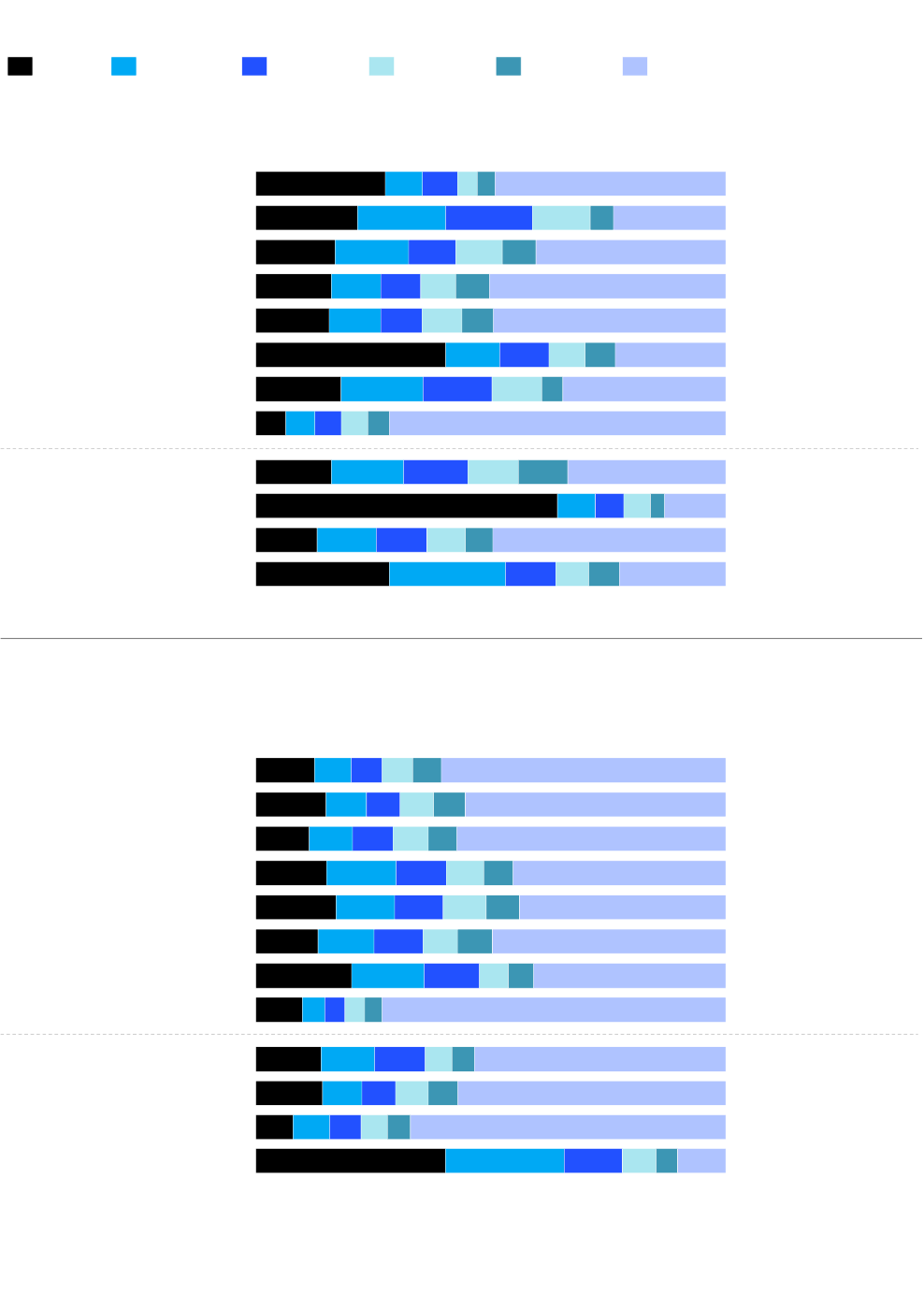
13Creating value, finding focus: Global Insurance Report 2022
Exhibit 10
Source: McKinsey Global Insurance Pools
Market share is highly fragmented in several countries.
Note: Figures may not sum to 100%, because of rounding.
France life comprises life insurance and capitalization; nonlife comprises P&C excluding accident.
Based on 2019 data.
Domestic business of all players in markets
Life insurance market share of top 5
insurers by premiums, 2020, %
Developed
markets
Emerging
markets
6 6 6
Italy
7
18
5
17 15 5 35
7
41
10
6
49
50
23
France
1
11 9 7 49
16 11 7
17
Germany
10 7
4
19
72
5
40
16 9
United Kingdom 16
11
10
22
7
United States
24Canada
Switzerland
18 12
11
428
8
Japan 9
8
China
2
11 728 23
8 613 50
India 8
14Mexico
Indonesia
6 13
1516
25
6 3
13
64
11
11
34
7
11
51
76
60
50
51
77
65
29
66
87
51
Top 5 market share,
life, 2020, %
77
40
45
43
55
56
50
59
27
47
43
33
90
10 5 4 73
21 6 6
10 7 7
10
13
9 7
Italy
12
4
France
1
44
15 15
50
11
41
6
17
9
7
60
Switzerland
45
United Kingdom 9 57
8
15 9
6
Canada
6
7
Japan
13
7
55
8
4
7
8
Germany 13
United States
6
15 12
11
25China
2
12 5 10
8 8
40
India
7
7
5 67
7
11
57
Indonesia
14
614
536
7
6
5Mexico 11
8
4th largest2nd largest 3rd largest Other5th largestLargest
Nonlife insurance market share of top 5
insurers by premiums, 2020, %
Top 5 market share,
nonlife, 2020, %
Developed
markets
Emerging
markets
Market share is highly fragmented in several countries.
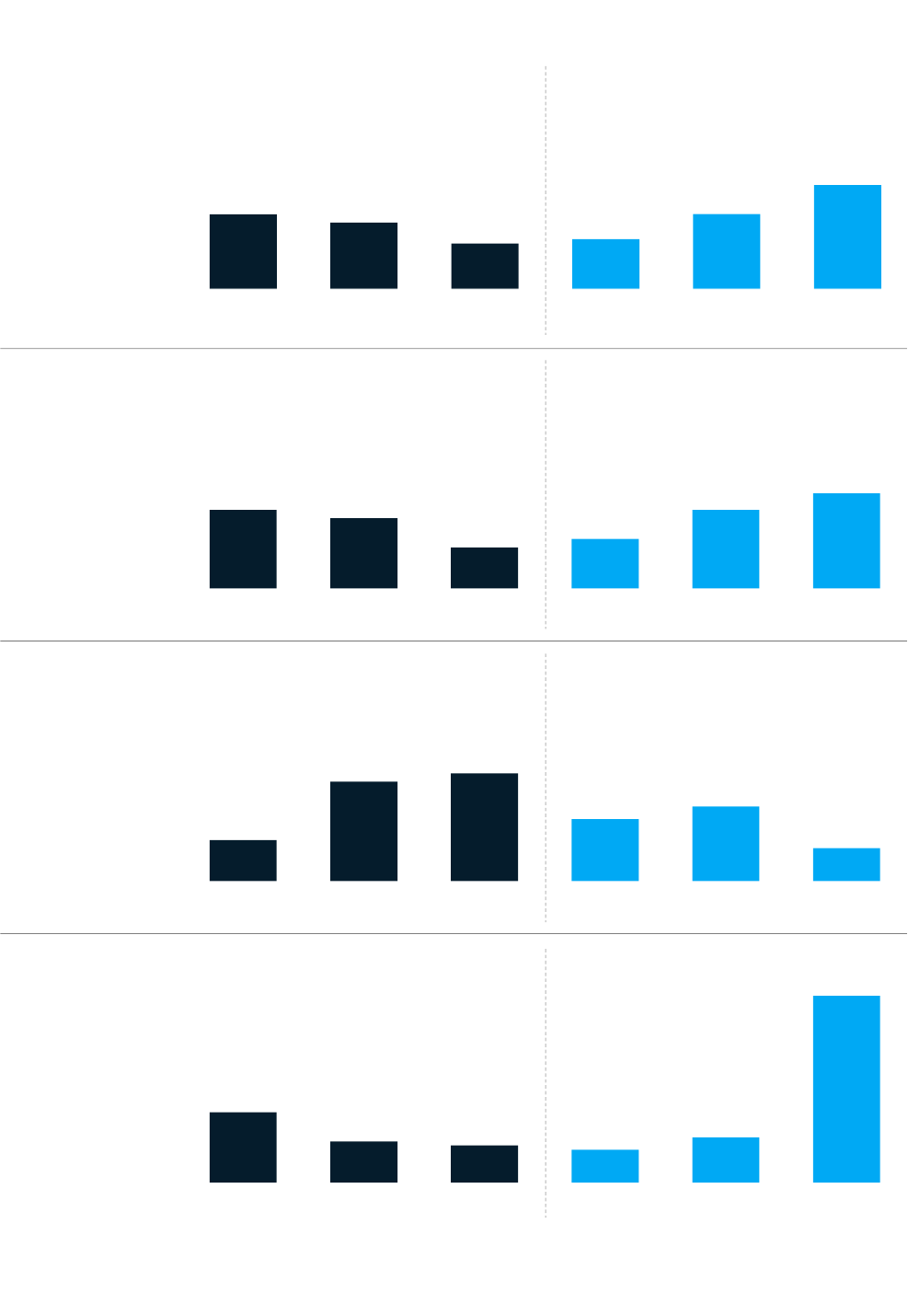
14 Creating value, finding focus: Global Insurance Report 2022
Exhibit 11
Source: McKinsey Global Insurance Pools
Many P&C insurers have struggled to reduce costs.
Changes in expense ratios are expressed as percentage point (ppt) dierence, 2014–19.
Distribution of changes in P&C insurance expense ratio 2014–19,¹ %
18%
12%
16%
18%
0 to 1 ppt
25%
<–3 ppt >3 ppt–1 to 0 ppt
11%
–1 to –3 ppt 1 to 3 ppt
Reduced ratioGlobal, n = 858
Americas, n = 672
Europe, Middle East, and Africa, n = 62
Asia–Pacic, n = 124
Increased ratio
18%
15%
24%
8%
26%
10%
1 to 3 ppt >3 ppt–1 to 0 ppt 0 to 1 ppt–1 to –3 ppt <–3 ppt
12%
17%
23%
19%
–1 to 0 ppt 1 to 3 ppt–1 to –3 ppt
10%
19%
>3 ppt<–3 ppt 0 to 1 ppt
9%
45%
>3 ppt0 to 1 ppt 1 to 3 ppt–1 to –3 ppt
8%
11%
17%
<–3 ppt
10%
–1 to 0 ppt
Many P&C insurers have struggled to reduce costs.
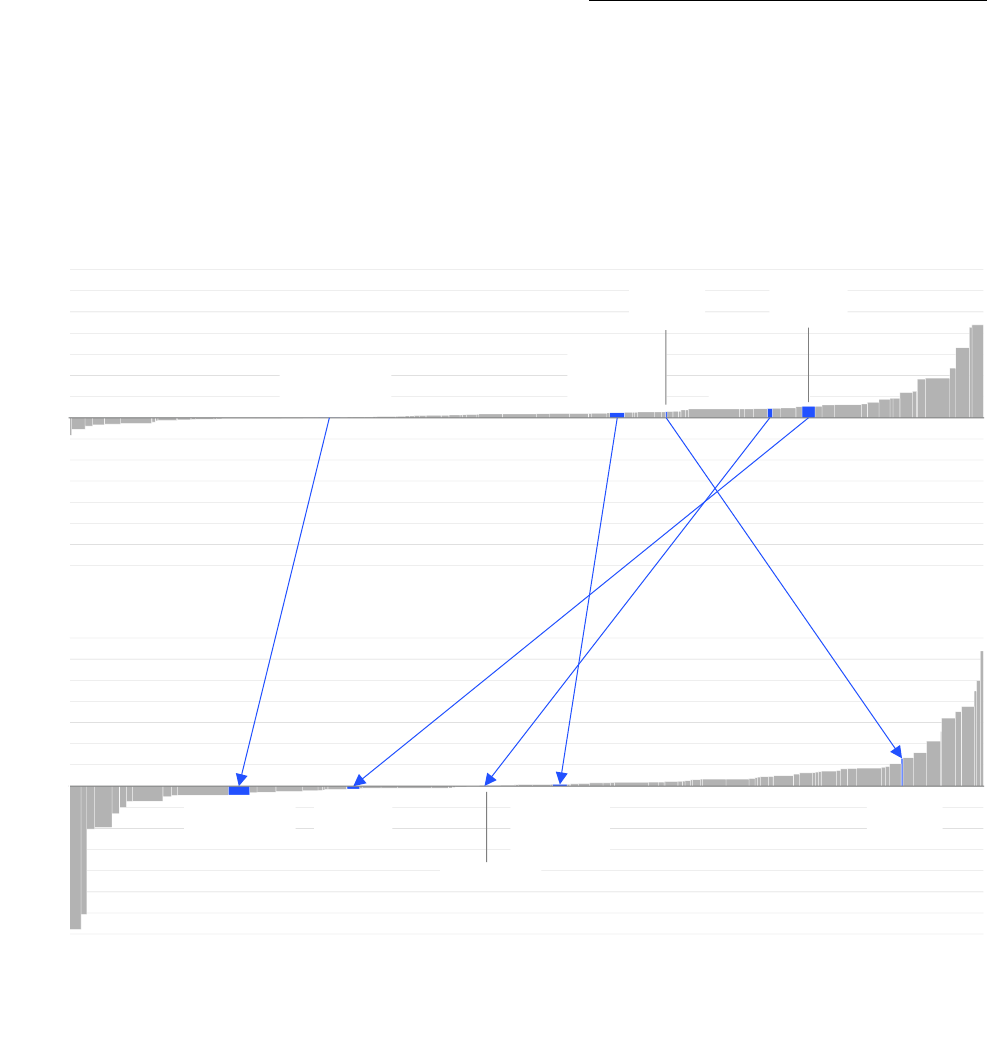
Insurance barely earns its cost of
capital, making investors skeptical
Together, these elements explain the industry’s
limited value creation recently. Exhibit 12 shows
the “power curve” distribution
15
of economic profit
of every sector in the economy. Not only has
the overall insurance industry destroyed value in
the past years, but its positioning has eroded from
200509 to 201519 (with insurance brokers as
the exception).
Looked at another way, industry average ROEs
have remained at or slightly below the cost of
equity over the past years, notably in North
America and Western Europe (Exhibit 13).
15
Alex D’Amico, Mei Dong, Kurt Strovink, and Zane Williams, “How
to win in insurance: Climbing the power curve,” McKinsey, June
18, 2019.
15
Creating value, finding focus: Global Insurance Report 2022
Exhibit 12
Source: S&CF Insights; S&P Global; McKinsey Corporate Performance Analytics
Insurance has had negative economic prot in recent years.
Based on the 2,689 largest companies globally where sucient data are available; including nancial institutions and private companies; excluding real estate
and real estate investment trusts.
Economic prot earned by an average company in 96 industries,
1
$ millions
–1,000
0
2,000
–2,000
1,000
3,000
–3,000
2005–09
2015–19
–3,000
3,000
1,000
–1,000
0
2,000
–2,000
Life and health
insurance
Life and health
insurance
Property
and casualty
insurance
Property
and casualty
insurance
Insurance
brokers
Insurance
brokers
Reinsurance
Reinsurance
Multiline
insurance
Multiline
insurance
Insurance has had negative economic profit in recent years.
After decades of stable
returns, insurance is
now a value-destroying
industry in which half
the players do not earn
their cost of equity.

This is not a problem caused by a few
underperformers. Rather, it is industry-wide:
54 percent of listed insurers, representing
52 percent of the global industry’s equity,
had an ROE below their cost of equity over
the past five years (Exhibit 14), raising questions
about the long-term economic viability of their
business model.
Not surprisingly, investors in the public markets
have taken note. Worldwide, about 50 percent
(depending on region and lines-of-business focus)
of listed insurance companies have consistently
traded below their book value over the past
five years (Exhibit 15). This is clearly a vote of no
confidence in the industry and raises questions
about the long-term future of several players as
stand-alone entities—particularly in multiline,
where about 60 percent of players are trading
below book value.
In summary, after decades of stable returns,
insurance is now a value-destroying industry in
16
Chris Bradley, Martin Hirt, and Sven Smit, “Strategy to beat the odds,” McKinsey Quarterly, February 13, 2018.
which half the players do not earn their cost of
equity. What can insurers do to beat the odds
and emerge from the current environment as
winners? Our research
16
across insurance and
other sectors has found that five bold moves,
pursued persistently, can propel players up
the power curve: dynamically reallocate capital
among businesses; reinvest a substantial share
of capital into organic growth and innovation;
pursue thematic and programmatic M&A (but not
megadeals); enhance underwriting margins; and
make game-changing improvements to achieve
top-quartile productivity. All of this has to be
done in a very different and rapidly changing
environment, and starting points vary greatly
among geographies and lines of business.
To acknowledge these differences and capitalize
on the tailwinds of change outlined above, we
have identified nine levers that insurers can pull to
improve value creation.
16 Creating value, finding focus: Global Insurance Report 2022
Exhibit 13
Source: Bloomberg; McKinsey Global Insurance Pools
Economic protability has slumped in several regions.
Cost of equity.
Insurers’ ROE by region, 2011–21E, %
15
5
20
10
2013 2021E2014 20202012 20162011 2017 2018 20192015
17.2
17.6
7.3
5.7
9.2
10.0
Average ROE,
2021, %
10.3
13.3
10.2
13.0
11.5
12.4
Average COE,
1
2017–21, %
Emerging Asia
Eastern Europe Developed Asia
Western Europe
North America
Africa and Middle East
Economic profitability has slumped in several regions.
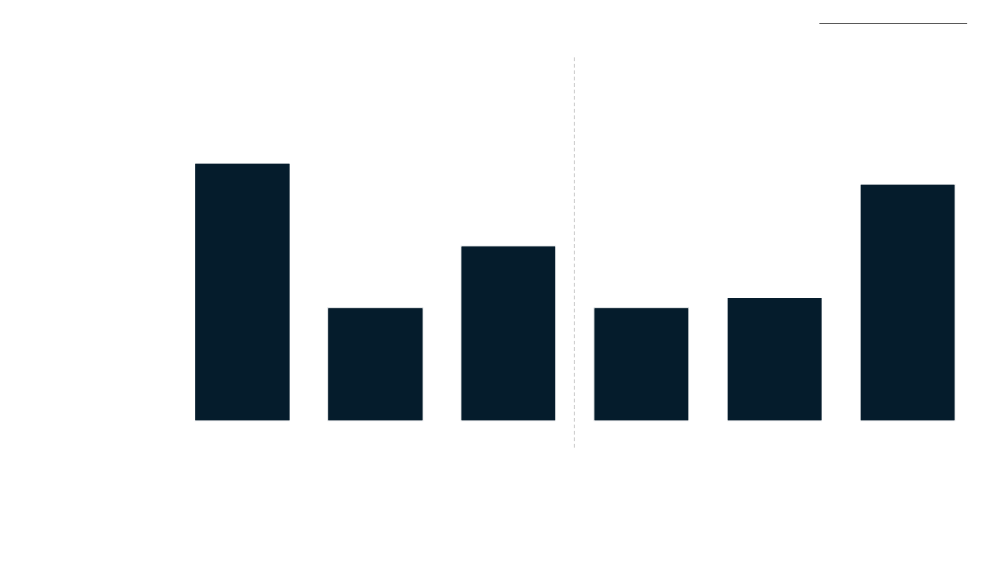
17Creating value, finding focus: Global Insurance Report 2022
Exhibit 14
Source: McKinsey Global Insurance Pools
More than half of insurers globally do not earn their cost of equity.
Note: Figures may not sum to 100%, because of rounding.
Percentage points.
Distribution of average ROE minus average cost of equity (COE), 2017–21, %
Listed players, n = 299
11%
12%
25%
11%
>5 ppt<–5 ppt
1
2.6 to 5 ppt
17%
0 to 2.5 ppt
23%
–5 to –2.5 ppt –2.4 to 0 ppt
Number of
insurers,
%
of insurers earn
less than COE
54%
of insurers earn
more than COE
46%
More than half of insurers globally do not earn their cost of equity.
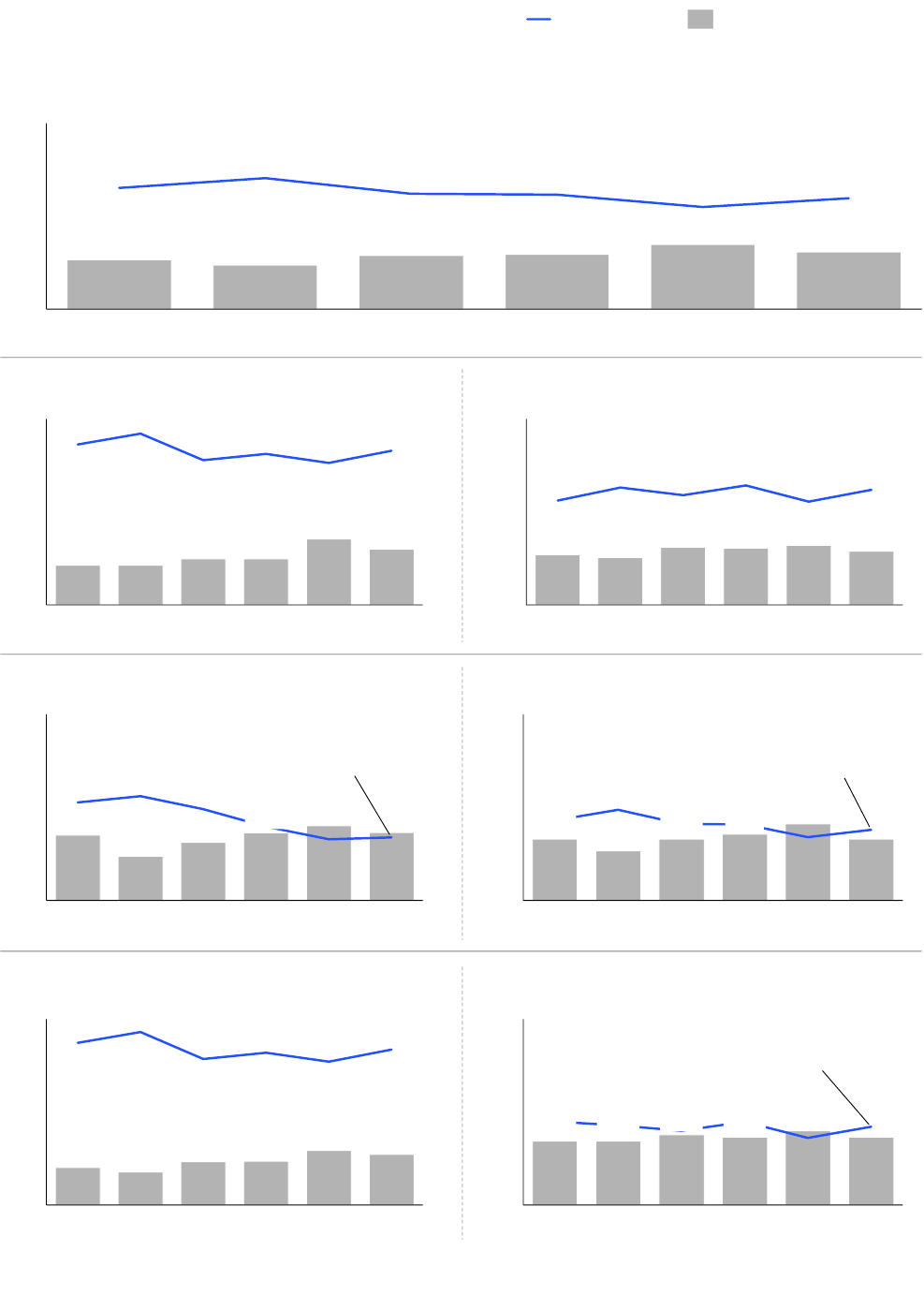
18 Creating value, finding focus: Global Insurance Report 2022
Exhibit 15
Source: Bloomberg; Capital IQ
More than half of insurers have been trading below book value.
Insurers’ price-to-book (P/B) ratio and proportion
trading below book value, 2016–21, %
World (n = 251)
Americas (n = 88) Europe, Middle East, and Africa (n = 116)
Asia–Pacic (n = 47)
P&C (n = 132) Multiline (n = 53)
0.5
0.0
1.0
1.5
172016
59%
19
52%
1.01
18
45%
49%
20
40%
2021
50%
1.5
1.0
0.5
0.0
202118
36%
17 19
42%
36%
2016
60%
42%
20
51%
1.41
1.5
1.0
0.5
0.0
46%
19
49%
18
54%
20
1.05
2016 2021
43%
52%
53%
17
0.5
1.0
1.5
0.0
60%
0.58
182016 17 19 2021
53%
62%
68%
40%
62%
20
0.0
1.5
1.0
0.5
30%
19182016
50%
40%
202117 20
34%
1.42
39%
46%
1.5
0.0
0.5
1.0
0.72
62%
18
62%
58%58%
19 2021
64%
68%
202016 17
1.0
0.5
0.0
1.5
0.65
2016 20
56%
70%
2021
61%
17 19
56%
45%
56%
18
Life (n = 66)
Insurance P/B Percentage of insurers
trading below book value
More than half of insurers have been trading below book value.

© Suzana Topita/Getty Images

© imageBROKER/Luca Renner/Getty Images
What can insurers do
to beat the odds and
emerge from the current
environment as winners?

3
Strategic
imperatives
for insurers
So far we have sketched the trends and challenges
buffeting the industry. Their effects run so
deep that insurers now face some fundamental
strategic questions:
— How can we improve shareholder
value creation?
— How can we unlock latent demand and improve
customer experience?
— How can we overcome
stagnating productivity?
— How can we reimagine the employee
proposition to attract and retain talent post-
COVID19?
— How can we frame the industry’s wider
purpose and role in society?
21Creating value, finding focus: Global Insurance Report 2022

Answering these questions is an urgent and
broadly transformational task. In our view, it
can be best accomplished by taking action on
the following nine imperatives:
— Make environmental, social, and governance
(ESG) considerations a core feature of
the business model. ESG issues increasingly
affect how all companies do business. More
and more companies and their investors
are recognizing ESG as a strategic priority
that involves significant business risks and
opportunities. In interactions with many
stakeholders, including at annual general
meetings of publicly listed insurers, ESG has
become a major theme.
But ESG is often used as a catchall term
covering many topics; for any given company,
just a handful of those topics will be of
supreme importance. As an illustration,
consider climate risk, an area in which
evidence is mounting that P&C insurers will
soon need to revisit their business models.
17
However, while many insurers have begun
to incorporate climate-risk considerations
in their investment processes, new-product
launches and underwriting processes are
mostly unchanged. With climate risk mounting,
insurers have an opportunity to broaden
the relevance of the industry’s traditional risk
transfer to explicitly address risk mitigation.
Five simultaneous actions can make this
happen: stress-test total exposure against
projected climate hazards; build resilience
and rebalance portfolios; help organizations
mitigate climate risk; create innovative
products to address climate-related risk; and
revise investment strategies.
— Regain relevance through product
innovation and coverage of new risks.
While the insurance industry has improved its
resilience and solvency in recent years, some
substantial risks have been left uninsured.
A fast-changing world is creating many
new and evolving risks—cyberrisks, climate
change, pandemics, intangible assets—that
remain underinsured, while other risks have
been gradually transferred to governments
to handle.
17
“Climate change and P&C insurance: The threat and opportunity,” McKinsey, November 19, 2020.
18
Sylvain Johansson, Andy Luo, Erwann Michel-Kerjan, and Leda Zaharieva, “State of property and casualty insurance 2020,” McKinsey,
April 22, 2020.
19
Ibid.
20
Simon Kaesler, Michael Krause, and Johannes-Tobias Lorenz, “The multi-access (r)evolution in insurance sales,” McKinsey, April 1, 2020.
Risks are rapidly evolving. In P&C commercial
lines, for instance, data and cybersecurity risk
and machine-learning liability are coming to
the fore. New risks call for new products and
a reallocation of priorities, and they represent
significant opportunities for P&C and life
insurers that are willing to innovate. Such firms
are taking three steps: making their products
modular, reallocating capital between
personal and commercial lines, and moving
quickly to establish strong market positions in
the new risks.
As noted, climate risk will require product
innovation. But even more innovation is
necessary as the insurability of entire regions
may come into question.
18
As our colleagues
have written, “The P&C industry can address
this issue by forming an industry-wide
coalition and collaborating more closely with
governments and regulators.”
19
At the very
least, requiring customers to opt out of
protection, rather than the current model
of opting in, could substantially increase
insurance penetration, as behavioral
science has shown. This raises the issue
of affordability; on that front, rather than
artificially suppressing risk-based rates,
governments and insurers might need stronger
public–private partnerships, including
government insurance voucher programs to
address affordability issues without losing
the highly valuable pricing mechanism
that signals risks back to the insured (for
example, to prevent building in areas with high
flood risk).
— Enhance and personalize customer
engagement and experience. New customer
behaviors require a shift in distribution.
Consumers are embracing digital channels and
have become used to delightful experiences
with leading tech companies. They expect
the same when buying insurance both online
and offline. A seamless, consistent “multi-
access” experience
20
in every channel is now
the gold standard for insurers. At the same
time, most customers still expect some form of
advice on most products. Addressing customer
needs and improving customer experience
thus does not necessarily mean going direct.
It might mean supporting distributors with
22 Creating value, finding focus: Global Insurance Report 2022

seamless, digital customer journeys that
let customers decide which topics they can
access digitally themselves and on which
topics they value personal advice (for example,
before buying a complex and low-frequency
product or in the case of a severe claim).
Major European and US carriers have not
moved as quickly as some players in Asia that
have seamlessly linked their digital platforms
and tied agent channels and invested in
customer personalization and engagement.
Carriers willing to launch this journey could
follow different approaches based on their
strengths and organizational capabilities. Many
insurers that traditionally rely on agents start
by providing digital tools to agents. Insurers
that depend on direct distribution are typically
far down the road of digitalization; they can
augment direct channels with tools to connect
customers with people. Carriers that rely on
both an agent network and direct channels
can build a true multi-access model that fully
integrates both agent and direct channels.
— Engage with ecosystems and insurtechs.
The ongoing drive toward digitalization has
also put the insurance industry on the verge
of a paradigm shift: as traditional industry
borders fall away, ecosystems will greatly
influence the future of insurers, with insurtechs
aiming to play a role in this recomposition of
the value chain. Our research suggests that
ecosystems could encompass $60 trillion in
revenue by 2030.
21
Many insurance executives are looking at
ways to engage with emerging ecosystems
in areas such as mobility, healthcare,
and the connected home. While only
the very largest insurers will be able to
create or orchestrate their own ecosystems,
the ability to connect with ecosystems will
be a prerequisite for growth for all carriers as
these systems gain in scale and customers
come to expect insurance products as part of
the offering.
Carriers will need to take a close look at their
relationships with end customers in the context
of purchasing journeys—such as buying a car,
going on vacation, and buying a home—and
decide how to embed solutions and services
alongside insurance coverage. To succeed,
insurers need to build the technological
21
Miklos Dietz, Hamza Khan, and Istvan Rab, “How do companies create value from digital ecosystems?,” McKinsey, August 7, 2020.
22
“Ecosystems and platforms: How insurers can turn vision into reality,” McKinsey, March 12, 2020.
23
Ari Libarikian and Kurt Strovink, “CEO brief: The future of business building in insurance,” McKinsey, June 2, 2021.
and organizational foundations as well as
the necessary partnerships to generate
value from their ecosystem approaches. Our
conversations with insurance executives
around the world suggest that leading carriers
take a three-stage approach
22
to participating
in or forming an ecosystem: strategize,
enable, and generate value. These stages
can help insurers implement ecosystems in
manageable, focused phases.
— Develop new businesses for the digital age.
Private investors have spotted the potential
for improvement and the not-too-distant
prospect of attractive returns in insurance.
They are investing heavily in insurtechs, whose
attractive talent pools can rapidly create and
scale new businesses.
In this context, incumbent carriers must
reinvent their business models to fulfill
the imperative to grow and, ultimately, to
deliver stakeholder value. As our colleagues
wrote recently, “New-business building is
emerging as a crucial strategic priority to drive
reinvention and innovation for the industry.
Part of the reason is speed: what used to take
years must now be done in months or weeks
to meet changing demands of the market.
Insurance executives must shift how they lead
their institutions—from a methodical pace
of change to the decisive reinvention of their
businesses. Many established companies
have tried and failed to build new businesses
from scratch. The ones that succeed combine
the speed of a start-up with the scale and
resources of the core business.”
23
Organizations that repeatedly build successful
new businesses exhibit six characteristics:
strong commitment from senior management,
obsession with value over ideas, a test-and-
learn culture, “open architecture” capabilities,
balance between organizational freedom and
corporate support, and dynamic performance
management and measurement. To get
started on new-business building, insurers
can look for opportunities that simultaneously
meet customer demands, square with
the organization’s strengths, and are sizable
enough to create real value.
— Scale impact from data and analytics. Most
insurance executives would agree that data
and analytics capabilities are becoming table
23Creating value, finding focus: Global Insurance Report 2022

stakes in the P&C and life sectors in Europe,
North America, and Asia.
24
Leaders see
enormous potential in best-in-class data and
analytics capabilities across the value chain,
even for the highest-performing companies.
For example, even the leading P&C insurers
can see loss ratios improve three to five
points, new business premiums increase
10 to 15 percent, and retention in profitable
segments jump 5 to 10 percent. However,
after years of investing and experimenting,
most insurers have not yet seen the return on
their investments at the enterprise level. While
individual pilots are successful, they realize
the real challenge is in scaling the impact to
the whole organization. We call this the pilot
trap; to escape it, insurers need to move
analytics from experiments to the mainstream.
This move requires a combination of distinctive
analytics, tools, frontline and management
routines, and investments in talent and
capability building. The ideal mix of these
elements will vary by line of business. Based
on our experience with similar efforts, getting
a few things right often determines whether
companies achieve their full potential. One
principle is to start small to learn and build
conviction—for example, by picking two lines
of business, one with strong performance
and another that is performing less well, to
prove impact. “Big bang” efforts made without
examples of the potential outcome often
fail to drive change. Another guideline: keep
the effort anchored in the C-suite; delegating
down can dilute long-term aspirations. Carriers
should also focus on the pace of execution:
in other words, speed is a strategy, especially
in the next 18 to 24 months, given evolving
market conditions. Fourth, carriers should
engage the front line throughout the effort
to help ensure lasting change; adoption by
users is the foundation for success. Finally, it’s
a good idea to link capital allocation decisions
to the latest market intelligence and insights
(at a high enough frequency to ensure you can
react to market shifts).
At the same time, technology is evolving
quickly. The next level will be to leverage
24
Kia Javanmardian, Sirus Ramezani, Ashish Srivastava, and Cameron Talischi, “How data and analytics are redefining excellence in P&C
underwriting,” McKinsey, September 24, 2021.
25
Ramnath Balasubramanian, Ari Libarikian, and Doug McElhaney, “Insurance 2030The impact of AI on the future of insurance,”
McKinsey, March 12, 2021.
26
Krish Krishnakanthan, Ani Majumder, Björn Münstermann, and Peter Braad Olesen, “Reaching the next normal of insurance core
technology,” McKinsey, July 2, 2020.
27
Alex D’Amico, Kweilin Ellingrud, Daniel Garza, and Nancy Szmolyan, “The productivity imperative for US life and annuities carriers,”
McKinsey, March 16, 2021.
even more advanced technologies to
enhance decision making and productivity,
lower costs, and optimize the customer
experience: as AI becomes more deeply
integrated
25
in the industry, carriers need to
understand the potential for AI to reshape
claims, underwriting, pricing, and distribution.
With this understanding, they can build
the skills and create the culture needed for
an AI-powered future.
— Modernize core technology platforms.
From 2012 to 2020, technology’s average
share of operating costs rose by 36 percent
for P&C and 10 percent for life. The key driver
is increasing digitalization—at both the front
end, where technology enhances the customer
experience, and the back end, where digital
drives productivity gains and operational
performance. Digitalization is straining legacy
systems, some of which are decades old, and
many insurers are considering a replacement
of core systems with tech platforms that
support the requirements of the digital age.
The challenge is that such projects can take
five to ten years, and they often last longer
and cost more than expected. Insurers
need to clearly pinpoint the real business
requirements, quantify the effects, and
then identify the tech changes required to
achieve them. A wholesale change of all core
systems is not always the right answer, and
the long timeline of such a change can prevent
carriers from adjusting to rapidly changing
market conditions.
To reach the next normal of core technology,
26
carriers will need to take three bold actions:
reimagine the relationship between the IT
group and other business functions, reinvent
the ways that IT delivers products and services
to internal customers, and anticipate the future
requirements of technology systems to provide
the organization with essential capabilities (but
without necessarily undertaking a complete
change of the IT stack).
— Address the productivity imperative. In
the current conditions, addressing structural
expenses
27
has become an even more
important source of value—especially given
24 Creating value, finding focus: Global Insurance Report 2022

the limited progress to date. Total expenses
relative to total revenues (including investment
income) increased by 20 percent from 2003 to
2019 for the life and annuities industry and by
6 percent for P&C insurance carriers. During
these same years, automakers and telecoms
companies successfully reduced their total
expense ratios by 15 percent or more.
28
Insurers need more than mere piecemeal
attempts at improvements. Only
a transformative approach
29
will allow
an insurer to survive and thrive in a post-
COVID19 world. Each carrier is unique, but
any company can begin the process to improve
productivity by establishing the trajectory
and full performance potential of the business
across the value chain—including sales and
distribution, product development, operations,
technology, and corporate functions.
With a clear vision, insurers can write
a comprehensive and detailed plan with clear,
measurable goals and assign responsibility to
specific executives. Financial, operational, and
customer-experience targets are all in scope.
Examples include straight-through processing
rates and all-digital policy application and
issuance rates in underwriting. Without both
clear goals and accountability, transformations
often deliver poor results.
To do the work, insurers should build a team
to continually and logically sequence all
the improvement initiatives so that every part
of the organization knows what to do and
when to do it in a harmonized way. A senior
executive should lead the team, holding people
accountable for their actions and their results.
The keys to success of such a productivity
transformation are top-management
conviction, leadership to challenge prevailing
orthodoxies and drive step-change
performance improvements, and a rigorous
execution machine that ensures delivery (and,
where required, adaptation) of initiatives.
— Reimagine culture, diversity, and ways of
working to attract and retain talent. Our
28
Ibid.
29
Alexander Erk, Pradip Patiath, Jonathan Pedde, and Jasper van Ouwerkerk, “Insurance productivity 2030: Reimagining the insurer for
the future,” McKinsey, October 8, 2020.
30
“It’s time for leaders to get real about hybrid,” July 9, 2021.
31
Aaron De Smet, Bonnie Dowling, Marino Mugayar-Baldocchi, and Bill Schaninger, “‘Great Attrition’ or ‘Great Attraction’? The choice is
yours,” McKinsey Quarterly, September 8, 2021.
colleagues summed it up recently: “Once in
a generation (if that), we have the opportunity
to reimagine how we work. In the 1800s,
the Industrial Revolution moved many in
Europe and the United States from fields to
factories. In the 1940s, World War II brought
women into the workforce (if not the C-suite)
at unprecedented rates. In the 1990s,
the explosion of PCs and email drove a rapid
increase in productivity and the speed of
decision making, ushering in the digital age as
we know it today. And in 2020, the COVID19
pandemic drove employees out of offices to
work from home. ... The return to the workplace
is a chance to create a new, more effective
operating model that works for companies
and people navigating a world of increasing
uncertainty. There is, however, one big catch:
employers must confront the broadening
disconnect between how they and their
employees see the future.”
30
Because of this
disconnect, a record number of employees
are quitting or thinking about doing so (the
so-called Great Resignation).
31
Many companies don’t really understand why
their employees are leaving. Without knowing
the true causes of attrition, companies
sometimes offer pay raises and bonuses that
fall flat. Rather than sensing appreciation,
employees sense a transaction. Leaders need
to start from scratch, question everything, and
make changes to the working model based on
the evidence.
There is no road map or playbook for this
unprecedented time. Experimentation will be
key. Carriers can try different working models
and norms, physical-space layouts, and tools
in service of a future that balances productivity
with creativity, personal flexibility with team
collaboration, and the office with the home.
That means experimenting and piloting as
individuals, teams, business units, offices, and
organizations. Letting experiments play out is
not easy for many leaders. A clear solution may
not be immediately apparent—the big answers
may not emerge for years.
25Creating value, finding focus: Global Insurance Report 2022

© Francesco Vaninetti Photo/Getty Images
Where should companies
play—in terms of geography,
lines of business, and
position in the value chain—
to renew themselves?

4
Where to play:
Focusing the
portfolio
Above, we outlined nine essential actions for
leaders to renew their companies and rejuvenate
value creation. While addressing these imperatives
would enable carriers to answer the “how to play”
question, we believe a related question is equally
pressing: Where should companies play—in terms
of geography, lines of business, and position in
the value chain—to renew themselves?
The pandemic years seem to herald a new phase
for the insurance industry. Several players are
already changing and refocusing their footprint
and business model—in effect, rebalancing their
portfolio of activities and reviewing their capital
allocation particularly through M&A and asset
disposals. Indeed, a new premise for industry
transformation may be emerging as carriers
realize that the changes unleashed by the COVID-
19 crisis will raise the stakes of competition
27Creating value, finding focus: Global Insurance Report 2022

while also complicating the macroeconomic
environment, especially through inflation and
interest-rate evolution. Carriers have to invest
quickly and massively in technology, data and
analytics capabilities, digital skills, the customer
experience, and compliance capabilities just to
keep pace in the changing environment. Those
investments won’t be easy to fund in an industry
with some disappointed shareholders. And
they carry an opportunity cost: as carriers with
diversified portfolios have many mouths to feed,
some areas will be shortchanged.
Insurers are realizing that the costs of
complexity (whether in the product portfolio,
client experience, geographical footprint, lines
of business, or position in the value chain) are
simply too high. More carriers are concluding
that it is better to simplify their operating model,
cede some benefits of diversification, and
invest the proceeds to gain scale where they
intend to operate. Thus, many carriers (though
not all; some are still pursuing global scale) are
shedding subscale, noncore businesses; seeking
profitability in their core activities and markets;
and gaining the ability to make bolder, more
focused investments. Many carriers believe they
will be able to renew value creation by offloading
legacy liabilities to owners better positioned
to manage them and by refocusing their
business model.
Consider a flurry of recent deals, each with focus
and local scale as the core strategic rationale.
Voya Financial recently sold its annuities,
life, and wealth businesses and doubled
down on retirement, asset management, and
group insurance. MassMutual, meanwhile,
divested its US direct-contribution business,
OppenheimerFunds, and its businesses in
Asia. Concurrently, it doubled the size of its
captive channel through an acquisition and then
acquired American Financial Group’s annuities
business to secure product scale in its core
insurance business.
Financial buyers have also entered the arena.
Private equity firms are rolling up insurance
and annuities assets
32
—typically sold by public
carriers—to secure permanent capital for their
investment arms. Recent deals include Apollo’s
acquisition of Athene, KKR’s deal for Global
Atlantic, Generali’s sale of its Generali Leben book
32
“Running up on runoff: Strategic options for life closed books,” McKinsey, February 10, 2021.
33
“A better approach to M&A in North American insurance,” McKinsey, March 9, 2021.
to Viridium, and Athora’s acquisition of VIVATlife
and asset management from Anbang. And some
global insurers have rethought their geographical
footprint; for example, AXA has sold its activities
in Central and Eastern Europe, Greece, the Gulf
region, Malaysia, and Singapore; Aviva has sold
most of its international businesses, including
operations in France, Italy, Poland, Singapore, and
Turkey; and Aegon has divested its businesses in
Central Europe and Turkey.
The next phase of M&A
The overall pace of M&A activity among insurers
and investors is likely to increase, though we
anticipate more activity among life insurers than
P&C. For life insurers, industry consolidation is
largely the result of macro challenges, including
sustained low interest rates and others that make
it difficult to achieve an attractive, sustainable
ROE. P&C insurers also face headwinds from
low interest rates—although less so than
their life insurance counterparts—as well as
an overabundance of carriers in many businesses,
resulting in downward pressure on ROE.
As the industry continues to restructure,
making a series of small deals could be a bridge
to a programmatic approach to acquisitions
for P&C and life insurers.
33
Our research over
the past 20 years has consistently shown that
a programmatic approach increases carriers’
odds of success as well as their potential for long-
term independence—if they can resist the allure
of very large acquisitions. Across industries,
programmatic M&A has worked best when
companies build dedicated teams and carefully
design processes based on best practices across
all stages of the M&A process, from strategy and
sourcing to due diligence and integration planning.
Today’s deal pace is strong; as that continues,
leading carriers can adopt those best practices to
fulfill their growth needs.
Both life and P&C insurers could focus on M&A in
existing businesses, and they could also increase
their presence in truly adjacent areas, as long as
they do not wander too far afield. For example, life
insurers could expand in businesses related to
asset and wealth management; P&C carriers could
move into service-provider functions in personal,
commercial, or specialty lines.
28 Creating value, finding focus: Global Insurance Report 2022

How to (re)focus portfolios
of activities
Over the past several years, most global
insurers’ strategies have centered on four areas:
productivity, economies of scale and scope,
greater exposure to higher growth markets, and
the benefits of diversification (including the impact
of Solvency II). As previously mentioned, these
moves have not yet been sufficiently radical to
trigger higher valuations. One could even argue
that investors now see insurers as a “value” play,
with no surprises and no volatility, a view that
removes growth and risk taking from the equation
(with a corresponding impact on market multiples).
Global insurers (those with a monoline presence
in several countries as well as multiline in a few)
thus face one pressing question: How should
they revisit their business model and portfolio of
activities to improve shareholder value creation?
For global insurers, the question of where to play
(and the related question of the “right to play”
of several carriers) may well be an existential
one: the next phase of the industry could deliver
a structure in which insurance liabilities are
reallocated toward their natural owners
34
—that is,
the companies whose distinctive characteristics
enable them to create more value in a given
business than other potential owners could. In
34
Richard Dobbs, Bill Huyett, and Tim Koller, “Are you still the best owner of your assets?,” McKinsey Quarterly, November 1, 2009.
a worst-case scenario, global insurers could
become irrelevant, with an industry slowly
moving toward a structure in which retail P&C
transfers to mutuals, bancassurance, and direct
players; commercial P&C goes to reinsurers and
specialists; life insurance goes to wealth, asset
management, and private-equity firms; and health
insurance becomes further entwined with public
healthcare systems. Considering the role global
insurers could play in addressing global issues
such as climate and pandemic risks, maintaining
their relevance becomes an urgent priority, for
them and for society at large.
Embracing a strategy of focus and local scale will
require a hard look at global insurers’ portfolios
of activities, as well as some tough decisions. We
believe they can renew value creation by moving
from a diversified, generalist, end-to-end business
model toward a sharper, (multi)specialist business
model. Many different flavors of focus will exist,
all potentially sound bases for natural ownership:
portfolios could be centered on a geography, a line
of business (potentially through disposals and
acquisitions), a distinctive value proposition along
the value chain, or the differentiating advantages
of private ownership.
For leaders who find the prospect enticing and are
excited to start such a transformation journey, we
Embracing a strategy
of focus and local
scale will require a
hard look at global
insurers’ portfolios of
activities, as well as
some tough decisions.
29Creating value, finding focus: Global Insurance Report 2022

suggest developing a rigorous understanding of
their starting point and then testing their strategy
against the following markers:
Geographical lens
1. Aside from your home market, where do you
have the position to achieve local scale and
generate profitability above cost of capital,
justifying investments?
2. How should you tackle high-growth markets
(such as Africa, emerging Asia, Latin
America, and the Middle East) that might
be the future of the industry but where you
might have a subscale business? Is there
an alternative path between divesting and
scaling investments without end (for example,
by spinning off the entity and keeping
a minority stake)?
3. Could you swap assets with other players
in the same situation as yours to find a new
equilibrium across multiple countries in
one go?
Lines of business lens
4. Taking a fine-grained approach to growth,
35
in
which lines of business should you focus your
efforts and investments? How can you divest
the ones where you cannot create value?
5. Where you decide to compete, how can you
promote innovation and cover new types
of risks or client segments to increase your
relevance in the market?
35
Mehrdad Baghai, Sven Smit, and S. Patrick Viguerie, “The granularity of growth,” McKinsey Quarterly, May 1, 2007.
6. Where you decide to compete, how can you
develop adjacencies or new services (for
example, generating tech-based revenues
such as BlackRock earns from Aladdin, its risk
management system)?
Value chain lens
7. Are you the natural owner of the main
building blocks of the insurance value
chain (distribution, technology,
administration, balance sheets and
underwriting, investments)?
8. Where you are not the natural owner, could
you outsource part of your value chain
to other players—even competitors—so
that you can focus your investments on
the distinctive elements of your value
proposition (for example, Wakam and iptiQ
acting as B2B2C providers without proprietary
distribution networks)?
9. Where you are the natural owner, could
you insource activities from other players
(for example, acting as a utility for other
subscale insurers)?
COVID19 has reset the playing field for the global
insurance industry. To stake out a profitable, fast-
growing position, many companies will need to pull
back on visions of global scale and instead find
their key source of competitive advantage—one
that makes them the best owner of their assets.
Pierre-Ignace Bernard is a senior partner in McKinsey’s Paris office, where Henri de Combles de Nayves is a partner;
Stephan Binder is a senior partner in the Zurich office; Alexander D’Amico and Kurt Strovink are senior partners in the
New York office; Kweilin Ellingrud is a senior partner in the Minneapolis office; Bernhard Kotanko is a senior partner in
the Hong Kong office; and Philipp Klais is an associate partner in the Munich office.
The authors wish to thank Tanguy Catlin, Nataliya Fedorenko, Jonathan Godsall, Shitij Gupta, Kia Javanmardian,
Johannes-Tobias Lorenz, Brad Mendelson, Rahul Mondal, Sirus Ramezani, and Sandra Sancier-Sultan for their
contributions to this article.
30 Creating value, finding focus: Global Insurance Report 2022

© Francesco Vaninetti Photo/Getty Images

Contacts
Africa
Umar Bagus
Partner, Johannesburg
Umar_Bagus@McKinsey.com
Americas
Lino Abram
Senior partner, Lima
Lino_Abram@McKinsey.com
João Bueno
Senior partner, São Paulo
Joao_Bueno@McKinsey.com
Tanguy Catlin
Senior partner, Boston
Tanguy_Catlin@McKinsey.com
Alex D’Amico
Senior partner, New York
Alexander_Damico@McKinsey.com
Kweilin Ellingrud
Senior partner, Minneapolis
Kweilin_Ellingrud@McKinsey.com
Jonathan Godsall
Partner, Toronto
Jonathan_Godsall@McKinsey.com
Kia Javanmardian
Senior partner, Chicago
Kia_Javanmardian@McKinsey.com
Rohit Sood
Senior partner, Toronto
Rohit_Sood@McKinsey.com
Kurt Strovink
Senior partner, New York
Kurt_Strovink@McKinsey.com
Asia
Violet Chung
Partner, Hong Kong
Violet_Chung@McKinsey.com
Eunjo Chon
Partner, Tokyo
Eunjo_Chon@McKinsey.com
Peeyush Dalmia
Senior partner, Mumbai
Peeyush_Da[email protected]
Alex Kimura
Partner, Singapore
Alex_Kimura@McKinsey.com
Bernhard Kotanko
Senior partner, Hong Kong
Bernhard_Kotanko@McKinsey.com
Brad Mendelson
Senior partner, Hong Kong
Brad_Mendelson@McKinsey.com
Angat Sandhu
Partner, Sydney
Angat_Sandhu@McKinsey.com
Europe
Pierre-Ignace Bernard
Senior partner, Paris
Pierre-Ignace_Bernard@McKinsey.com
Stephan Binder
Senior partner, Zurich
Stephan_Binder@McKinsey.com
Henri de Combles de Nayves
Partner, Paris
Henri_de_Combles_de_Nayves@McKinsey.com
Sylvain Johansson
Senior partner, Geneva
Sylvain_Johansso[email protected]
Johannes-Tobias Lorenz
Senior partner, Dusseldorf
Johannes-Tobias_Lorenz@McKinsey.com
Jörg Muβhoff
Senior partner, Berlin
Joerg_Musshoff@McKinsey.com
Sirus Ramezani
Senior partner, Zurich
Sirus_Ramezani@McKinsey.com
Sandra Sancier-Sultan
Senior partner, Paris
Sandra_Sancier-Sultan@McKinsey.com
Gökhan Sari
Senior partner, Istanbul
Gokhan_Sari@McKinsey.com
32 Creating value, finding focus: Global Insurance Report 2022

Media contact
Julie Crothers
Julie_Crothers@McKinsey.com
33Creating value, finding focus: Global Insurance Report 2022
Exhibits in this article are based on McKinsey’s Global Insurance Pools, a comprehensive insurance
database providing data and insights pertaining to the global insurance industry. Our suite of offerings
includes market financials (more than 150,000 data points covering the 66 largest insurance countries
worldwide and 99 percent of global insurance premiums), insurer financials, deep dives into commercial
lines and direct distribution, insights on customers’ multichannel purchasing journeys, and in-depth
views on the insurtech landscape. In addition to databases, the McKinsey Global Insurance Pools team
also provides tailored support, insights, and analysis. For more information, please visit our website or
contact us at gip@mckinsey.com.

McKinsey & Company
February 2022
Copyright © McKinsey & Company
Cover image: Getty Images
www.McKinsey.com
@McKinsey
@McKinsey
@McKinsey
Creating value, finding focus: Global Insurance Report 2022
